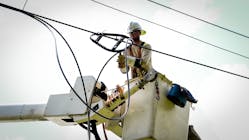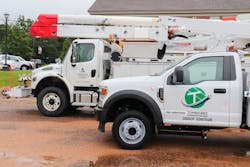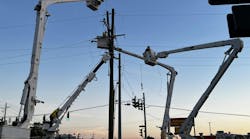With 116 years of experience providing affordable, reliable electricity, Alabama Power, a unit of Southern Co., has a history of leveraging technology to improve its operations. Since the 1980s, the utility has added to its mix of technologies and existing infrastructure — supervisory control and data acquisition (SCADA), long-term evolution (LTE) network, fiber, system automation, remote control, integrated distribution management system/advanced distribution management system (IDMS/ADMS), fault isolation and service restoration (FISR) — by using them in tandem to operate an advanced, efficient and reliable distribution system.
As Alabama Power works to strengthen its grid, manage the distribution system efficiently and cut restoration times, it relies on dynamic data. The utility uses ADMS software, which integrates the SCADA, distribution management system (DMS) and outage management system (OMS). This provides a platform for all the tools and applications necessary to enable system users to gain situational awareness in a live, dynamic format.
One of the most important aspects of ADMS is FISR, a model-based application that analyzes emerging outages to develop restoration plans, checks plan feasibility against power flow results and implements the plan using SCADA. Since its inception at Alabama Power in 2018, FISR has been a catalyst for improving restoration efforts. It has helped to significantly reduce the customer minutes of interruption (CMI) and system average interruption duration index (SAIDI). With FISR, the utility has avoided more than 237 million CMI and improved SAIDI in 2021 by almost 12%.
Power Delivery Data Analytics
In 2019, Alabama Power established a power delivery data analytics (PDDA) team to serve as a support organization. This team uses data to create actionable insights that drive innovation, promote improved system performance and increase customer satisfaction, while responding to shifting landscapes in the industry and inputs from end users and customers.
“We’re combing through real-time system data and analyzing it to identify assets that are the least reliable for our customers and have the most operations and maintenance costs, and then addressing those areas with smarter capital deployment strategies,” said Shane Powell, manager of data analytics and connectivity
at Alabama Power. “It’s a major win for our customers, our employees and our system.”
By leveraging rich data sets from ADMS, advanced metering infrastructure (AMI), FISR, geographic information systems, accounting systems and fiber systems, the PDDA team ingests, analyzes and visualizes data to produce insightful and actionable analytics for the overall system.
One such use case was creating a methodology to predict reliability performance and operational costs at a granular level across the system for both present and future states. These insights are used to suggest targeted deployment of capital investments on the lowest-performing assets, allowing improvements in reliability and reducing operation and maintenance costs.
SCADA Development
Alabama Power began developing a distribution SCADA system in the mid-1980s, primarily supporting substation equipment. After two pilot programs, a system (now owned by General Electric) was placed into production in 1991 and the project was expanded to automate line devices in addition to the
distribution substations.
The initial SCADA deployment gave real-time visibility into the grid and enabled remote operation of devices traditionally operated manually. In 2017, Alabama Power began upgrading its SCADA communications to long-term evolution (LTE) over Southern Linc, Southern Co.’s wireless, push-to-talk communications network. This upgrade moved SCADA to a more secure protocol on a private network, where it could take advantage of Southern Linc’s reliability.
Today, Alabama Power has nearly 800 automated distribution substations and 9000 distribution line devices online.
AMI Technology
After many years of testing and large proofs of concept, Alabama Power selected Sensus Flexnet as its AMI technology in 2006. Flexnet is a two-way, fixed-base AMI network that uses licensed spectrum and purpose-driven protocols for electric, gas and water metering. Deployment of Alabama Power’s 1.5 million electric AMI meters started in 2007 and was completed in 2010. Since deployment, the utility has used its AMI technology to fundamentally change the way it bills customers, forecasts revenues, monitors the distribution system and restores power.
A meter is more than just a device to register power; it is intelligence equipment that provides customers with smart insights, a distribution sensor that has awareness of all distribution anomalies that could impact reliability and a revenue meter that provides customers the ultimate flexibility on when and how they use energy.
With this strategy, Alabama Power aims to change how the industry thinks about AMI meters and establish what is possible for the future, gathering functional requirements for the next generation of AMI.
“We continue to find opportunities to use AMI data to enrich our existing business processes and analytics efforts,” said Brandon Lundy, AMI management systems manager at Alabama Power. “In many ways, AMI data symbolizes our customer; it is the demarcation between our distribution system and our customers’ experience.”
Undergrounding Strategy
Beyond using dynamic data to improve restoration efforts, Alabama Power is making significant strides to improve service and reliability in communities across the state of Alabama by replacing overhead power lines and equipment with underground lines, where appropriate and feasible.
In 2017, Alabama Power piloted a program to convert certain existing overhead distribution lines to underground, targeting those that required high levels of maintenance because of difficult accessibility. In 2021, coordination of the program shifted to the utility’s power delivery central engineering group. The team uses a data analytics tool, called Grid Inform, to guide selections with input from local engineering offices.
With two primary types of projects now in line — rear-lot residential and single-phase, high-vegetation management radial lines — the goal is to improve reliability and cost savings.
Increased Automation
In conjunction with a robust undergrounding strategy, Alabama Power is increasing the number of protective devices on a given distribution feeder, reducing the number of customers between protective devices and, ultimately, the number of customers impacted by an outage.
Automation has been on Alabama Power’s distribution system since the 1990s. Since then, the utility has continued to increase the amount of automation through different initiatives and programs, such as the Smart Grid Investment Grant (SGIG). In 2017, the utility created a 10-year automation strategy to deploy and install more than 5000 additional electronic recloser devices on its distribution system.
The goal is to segment customers into blocks of 300 to 400 and place devices at locations with decreased line exposure. Increasing the number of electronic reclosers will give system operators and FISR more options to keep customers protected from sustained outages.
Another piece of this automation strategy involves dropout reclosers. By installing these types of devices in place of fused cutouts, permanent outages caused by temporary faults can be mitigated, leading to improved reliability and cost savings.
Improving Connectivity
Alabama Power first used fiber optics for communication in the mid-1970s to alleviate inherent issues of traditional metallic telephone cable that extended from a tower to Mitchell Dam.
In 1985, the utility entered the first of several joint-venture fiber-optic projects with commercial telecommunications carriers. These projects used the then-state-of-the-art technology of optical ground wire (OPGW) cable, replacing shield wire on electric transmission lines with a metallic conductor containing optical fibers in a central tube. The communication systems operating over these fibers provided enterprise voice and data communications between Alabama Power, its regional offices and Southern Co. affiliates, delivering enterprise and control communications to electric generating facilities located within reasonable proximity to the fiber routes.
“Alabama Power has been installing fiber-optic cable for years to support the reliability of its electric operations and to facilitate secure, high-speed communication and data transfers,” said Suzanne Hoffman, Southern Co. Services telecommunications engineer.
Two-Way Communications
Alabama Power’s advanced grid requires two-way communications that enable dynamic customer engagement with resources distributed across the T&D grid.
Southern Co.’s LTE network evolved from a decades-old communications challenge — how to meet the mobile needs of the company across a large territory. Over the years, Southern Co.’s subsidiaries tried to meet this challenge by using individual two-way radio systems with varying technologies. While useful when meeting a specific utility need, there was no interoperability when operating companies worked together as a team. In 1993, Southern Communications was formed, launching the Southern Linc network in 1996. Following a tremendous amount of work by telecommunications professionals across the enterprise, in 2018, Southern Co. became the first utility in the U.S. to deploy a private LTE network.
In addition, Alabama Power purchased priority access licenses (PALs) of 3.5-MHz spectrum in the U.S. Federal Communications Commission’s 2020 3.5-MHz spectrum auction to be contiguous across the utility’s service territory as an important piece of the long-term communication strategy for grid modernization.
“Data demands on Alabama Power’s grid are predicted to increase by eight times by 2030 due to longer-term communication needs,” said Meredith Morgan, Alabama Power’s data analytics and innovation engineer. “We’re continuing to modernize how we meet these needs and provide energy to customers by deploying telecommunications infrastructure to support the grid.”
Long-Haul Fiber Initiative
Fiber has been part of the transmission system for 20 years to 30 years, mainly as OPGW. Alabama Power has developed new initiatives on its transmission system to further the fiber footprint throughout Alabama.
The utility’s long-haul fiber initiative was created to address this need. Conduit, fiber and colocation infrastructure are being installed on transmission rights-of-way across the state. Long-haul communication thoroughfares connect major hubs, cities, towns, generation plants and substations. These new underground routes are in addition to existing and new OPGW projects on the transmission system, and they will eventually cover much of the state, providing both critical communication routes for operational needs.
Fiber to Distribution Program
In addition to fiber initiatives on Alabama Power’s transmission system, the utility’s power delivery organization began a program in 2017 to blanket distribution feeders around the state with fiber-optic cable. The primary driver of this program is to support core electric operations, but this infrastructure also can support new initiatives and economic development opportunities.
When it comes to supporting the distribution electrical system through traditional methods, only a finite number of devices can be installed on a given feeder and properly coordinated. Trip timing and coordination are no longer limiting factors when using high-density coordination (HDC) and fiber-optic connectivity.
“Not only is it important for Alabama Power’s grid devices to have reliable, secure and resilient communications, it’s just as important for control centers, engineering offices and facilities to have this same quality of communication,” said Tommy House, Alabama Power’s connectivity supervisor. “Whenever possible, Alabama Power makes an effort to get these locations on company-owned and -maintained fiber.”
Healing the Digital Divide
Alabama Power identified a problem it wanted to help its customers with: Alabama’s broadband rankings and access to high-speed internet lag behind much of the U.S.
By creating public-private partnerships, promoting sound legislation and collaborating companywide, Alabama Power has driven gains in bridging the state’s digital divide. By strategically using fiber deployments planned for the electric grid, the utility has identified an opportunity to serve as an infrastructure solution for telecommunications companies, specifically in rural areas.
While telecommunications companies often build in high-density areas that provide better financial returns, the electric utility business model focuses on delivering reliable service to all customers. Utilities have existing telecommunications infrastructure — including spectrum and fiber — that can be used to serve customers in rural, suburban and urban areas alike.
“Alabama Power’s fiber strategy makes its grid smarter, more reliable and resilient for customers, while providing an asset to help facilitate the expansion of broadband services to our service territory,” said R.B. Walker, Alabama Power’s director of legal affairs. “Much like every corner of Alabama benefited from the expansion of electricity, connectivity can create the same opportunity and accelerate the foundation electricity built.”
However, transformational change cannot be made alone. Alabama Power actively sought internal and external partners to help lay the proper groundwork and develop policies to facilitate this change. Externally, a 30-member coalition worked to help pass state legislation to bring more companies on board to connect Alabamians.
Each fiber deployment builds surplus capacity, providing an extra asset that can be crucial to bringing high-speed internet to the “middle mile.” Alabama Power recognized it could play an important role by partnering to use its middle-mile infrastructure as the backbone network for telecommunications providers’ service builds. These broadband partnerships cover the costs of grid enhancements, providing customers more reliable service without additional charges.
Beyond broadband expansion, Alabama Power continues to leverage partnerships to improve the customer experience and help communities and businesses across the state to live and work smarter. These include weather camera installations with the Barron Weather Institute, leveraging the existing AMI network for metering solutions and the development of outage alerts to provide real-time outage information to customers.
To meet customers’ needs now and for generations to come, Alabama Power constantly enhances and modernizes its electric grid, investing in grid technology and improving resiliency.
“This comprehensive puzzle of engineering, technology, innovation and implementation…is something we’ve worked to develop for decades and are continuously working to enhance as we make smart investments for the homes, schools, businesses and industries who rely on us,” said Grant Rogers, Alabama Power’s connectivity supervisor.
The grid is evolving rapidly with new technologies, new forms of generation and increasing customer demands on utilities. Innovation is critical to maintaining a reliable, resilient and secure electrical grid.
Editor’s note: For more information on Alabama Power’s grid resiliency efforts, visit www.alabamapower.com/smart-energy/sustainability/resiliency.html.
Jessica Nissenbaum is a senior communications specialist in Alabama Power’s PR organization, specializing in internal and executive communications. She provides public relations and strategic counsel to internal stakeholders, including human resources, diversity, equity and inclusion, innovation, power delivery and crisis communications. She supports the management of the company’s employee communications platform. Jessica has more than 14 years of professional PR experience, and has held positions in the energy, nonprofit, healthcare and franchising industries in both Atlanta and Birmingham.





